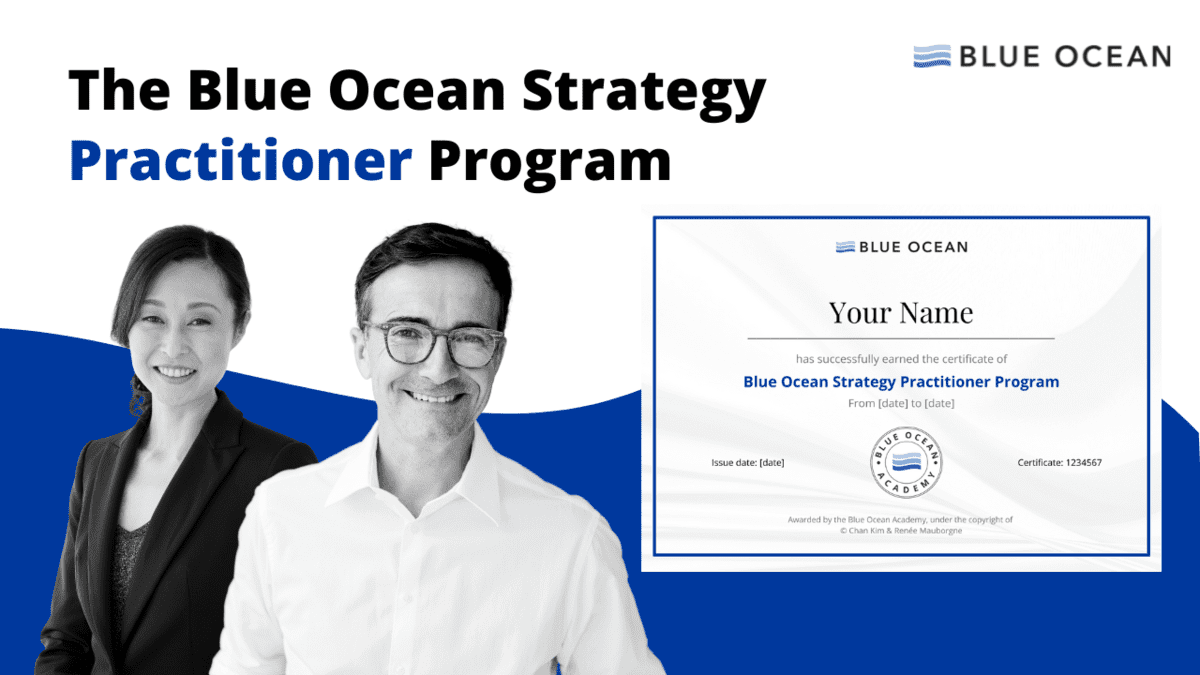-
 Red Ocean vs Blue Ocean Strategy
Red Ocean vs Blue Ocean Strategy
-
 Value Innovation
Value Innovation
-
 Strategy Canvas
Strategy Canvas
-
 Buyer Utility Map
Buyer Utility Map
-
 Three Tiers of Noncustomers
Three Tiers of Noncustomers
-
 Six Paths Framework
Six Paths Framework
-
 Four Actions Framework
Four Actions Framework
-
 ERRC Grid
ERRC Grid
-
 Pioneer Migrator Settler Map
Pioneer Migrator Settler Map
-
 Price Corridor of the Mass
Price Corridor of the Mass
-
 Sequence of Creating a Blue Ocean
Sequence of Creating a Blue Ocean
-
 Five Steps to a Blue Ocean Shift
Five Steps to a Blue Ocean Shift
-
 Three Components of Blue Ocean Shift
Three Components of Blue Ocean Shift
-
 Three Components of Humanness
Three Components of Humanness
-
 Four Hurdles to Strategy Execution
Four Hurdles to Strategy Execution
-
 Fair Process
Fair Process
-
 Tipping Point Leadership
Tipping Point Leadership
-
 Blue Ocean Vs Conventional Leadership
Blue Ocean Vs Conventional Leadership
-
 Leadership Canvas
Leadership Canvas
-
 Blue Ocean Leadership Grid
Blue Ocean Leadership Grid
-
 Four-Step Blue Ocean Leadership Process
Four-Step Blue Ocean Leadership Process
-
 Cost of Disengaged Employees
Cost of Disengaged Employees
FAIR PROCESS
Fair process is a concept developed by Chan Kim and Renée Mauborgne that builds execution into strategy by creating people’s buy-in up front. When fair process is exercised in the strategy formulation phase, people trust that a level playing field exists, inspiring voluntary cooperation during the execution phase.
There are three mutually reinforcing elements that define fair process: engagement, explanation, and clarity of expectation. Whether people are senior executives or shop employees, they all look to these elements. Chan Kim and Renée Mauborgne call them the three Ε principles of fair process.
Engagement
Explanation
Expectation Clarity
© Chan Kim & Renée Mauborgne. All rights reserved.
It should be noted that any subset of the three is insufficient. The three criteria collectively lead to judgments of fair process.
-
 Red Ocean vs Blue Ocean Strategy
Red Ocean vs Blue Ocean Strategy
-
 Value Innovation
Value Innovation
-
 Strategy Canvas
Strategy Canvas
-
 Buyer Utility Map
Buyer Utility Map
-
 Three Tiers of Noncustomers
Three Tiers of Noncustomers
-
 Six Paths Framework
Six Paths Framework
-
 Four Actions Framework
Four Actions Framework
-
 ERRC Grid
ERRC Grid
-
 Pioneer Migrator Settle Map
Pioneer Migrator Settle Map
-
 Price Corridor of the Mass
Price Corridor of the Mass
-
 Sequence of Creating a Blue Ocean
Sequence of Creating a Blue Ocean
-
 Five Steps to a Blue Ocean Shift
Five Steps to a Blue Ocean Shift
-
 Three Components of Blue Ocean Shift
Three Components of Blue Ocean Shift
-
 Three Components of Humanness
Three Components of Humanness
-
 Four Hurdles to Strategy Execution
Four Hurdles to Strategy Execution
-
 Fair Process
Fair Process
-
 Tipping Point Leadership
Tipping Point Leadership
-
 Blue Ocean Vs Conventional Leadership
Blue Ocean Vs Conventional Leadership
-
 Leadership Canvas
Leadership Canvas
-
 Blue Ocean Leadership Grid
Blue Ocean Leadership Grid
-
 Four-Step Blue Ocean Leadership Process
Four-Step Blue Ocean Leadership Process
-
 Cost of Disengaged Employees
Cost of Disengaged Employees
Fair Process: Managing in the Knowledge Economy
How companies can tap into the voluntary cooperation of its people by building trust through fair processes

BLUE OCEAN SPRINT with AI NAVIGATOR
Kickstart Your Growth, Break Free from Competition, and Redefine Your Market to Seize New Opportunities
Leverage the new AI Navigator, your superpowered Blue Ocean-trained partner in strategy and put it to work for your business.
“LOVED this course. No nonsense, 100% practical tools I can start implementing TODAY in my organisation!” Amalia C., Google
THE BLUE OCEAN STRATEGY PRACTITIONER PROGRAM

Transform your strategic perspective, master blue ocean tools and frameworks, & learn to unlock new growth opportunities
Get started with new market creation with our live, interactive, expert-led program.